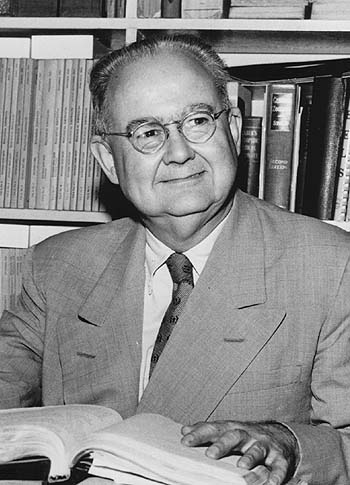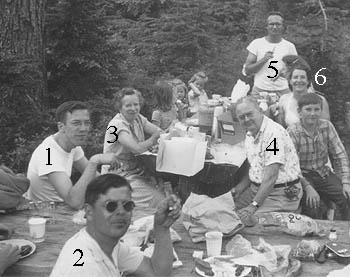
University of Washington Library
Melville Harrison Hatch
The Pacific Northwest's Greatest Coleopterist
1898 - 1988
Copyright © 1988 by Rod Crawford
 |
| Photo courtesy Special Collections, University of Washington Library |
Melville "Mel" Hatch was born in Detroit, Michigan on November 25, 1889. His father was Charles H. Hatch (1866-1948). Mel's interest in animals began with a trip to the circus at the age of three; aged nine, he "began to compile a catalogue of the animal kingdom;" he started to collect insects when he was fifteen. Mel attended Detroit Central High School, where he belonged to the Biology Club, and the University of Michigan, where he got his B.A. in 1919, M.A. in 1921, and Ph.D. (Zoology) in 1925. His dissertation was on the ecology, phylogeny and morphology of Gyrinidae (whirligig beetles). Among his college room-mates were T. H. Hubbell, later a renowned orthopterist (I have Hatch's copy of Hubbell's camel cricket monograph, inscribed from "Hub") and Arthur Ortenburger, founding editor of The Biologist magazine (published by Phi Sigma, the biological research society), which Hatch was later to edit himself. He joined Phi Sigma in 1918 and remained active in it most of his life.
Hatch's early research interests were in the beetles of Michigan and particularly the water beetle family Gyrinidae. His first publication, "A Preliminary list of the Coleoptera of the Cranberry Lake region, New York" appeared in 1924 and was followed by more than 180 others through 1971.
After a brief stint at James Millikin University, Decatur, Illinois, he served as teaching assistant and instructor at the University of Michigan through 1926, then for a year as instructor at the University of Minnesota (where he published "Studies on the carrion beetles of Minnesota," his 22nd paper), before coming to the University of Washington in fall of 1927 as an assistant professor.
Hatch took over the teaching of entomology at the U.W. from Trevor Kincaid, the protean Washington biologist who had collected insects and spiders since boyhood and was an acting professor while still an undergraduate. The first several weekends after Hatch's arrival were occupied by Kincaid's showing him all the favorite local collecting spots, the beginning of a lifelong pursuit of Northwest beetles.
 |
| Scarabs picnic, July 1950, with (1) Dennis Boddy, (2)
Roger Hall, (3) Estelle Hatch, (4) Mel Hatch, (5) Ervin Dailey, (6) Helen Gellermann Houk, and parascarabs |
Nearly ten years after his arrival here, Hatch had accumulated a small coterie of fellow beetle enthusiasts, mostly current or former students, and on June 6, 1937, eight of these met at the Hatch home at 5547 25th Ave. NE, Seattle (he still lived near here when I knew him in the early 70s) to form "a social group where it would not be out of order to talk about beetles!" Hatch was the leader, or High Scarab. The early history of Scarabs is given in detail on a separate page. The group still flourishes today after 67+ years and some 650 meetings; click here for current info.
In the 1930s and 40s, Hatch added some new research interests: terrestrial isopods (sowbugs), greenhouse fauna, the works of Charles Darwin and history of Darwinism (he owned numerous Darwin first editions), Egyptian scarabs, and the history and philosophy of science. In 1943 he became involved with teaching a U.W. series of General Studies courses called The Modern Cultural Crisis, for which he produced numerous mimeographed essays on science, religion, politics, and life in general. I have copies of many of these exceedingly rare little gems, such as Biology and Politics (1943), What is Man? (1944), and Knowledge (1968); see the quotations page for a few excerpts.
Beginning in October 1948, Hatch served on the university's Committee on Tenure and Academic Freedom which considered the case of 6 faculty members "charged with subversive communist activity." The committee recommended firing one, but the administration fired three, who never worked in academia again. Hatch's writings seen by me hold few clues to his personal feelings on the "general problem of how much political activity is proper to faculty members" but his essays show clearly enough that he had as little sympathy with Communist ideology as any Cold War American.
Having been promoted to full professor in 1941, Hatch wrote in late 1947 "On June 11, following Dr. Arthur Svihla's resignation, I became acting executive officer of the Department of Zoology at the University. If at that time I had any doubts as to my temperamental suitability for such a position, they have since been quite removed, and I wait impatiently my successor..." That successor, Prof. Arthur Martin, took over in April 1948 and "my attentions became released for more interesting if not more important things," namely the formal writing of his life's work, Beetles of the Pacific Northwest, started in June 1948.
He envisioned the project as taking "five or ten years." Dreamer! The fifth and final volume appeared in 1971, 23 years later! Hard at work on part 5 in 1967, he wrote "A reviewer ... in Science observed that several large phytophagous families remained to be covered, and he wasn't kidding!" The project also involved many collecting trips and visits to other collectors and museums. Volume 1 was submitted to the U.W. Press in 1950 but not published until December 1953 (and yes, they're still that slow if not slower!) In 1952 and 1955 extensive trips were made to Eastern museums to check identifications against type specimens. But apparently Hatch's only travel outside North America was to the Vienna (Austria) entomological congress of 1960. Students (many of them Scarabs) contributed extensively to both collecting and writing of the Northwest beetle monograph. Even if all else is forgotten, this monumental work will have earned Hatch an enduring place in entomological history, describing some 4,300 beetle species from Washington, Oregon, Idaho and British Columbia. Any user of the work soon becomes used to Hatch's unique descriptive prose, full of words very precise in meaning but far from obvious to the casual browser. Once one's vocabulary expands to include "alutaceous," "rufotestaceous," "aeneous," "mucronate," "declivous," "strigulose," etc. etc., all becomes clear as day!
Other book-length Hatch publications include Catalogue of the Injurious Insects of Washington (1938), Isopods of Washington (1947 but still useful today), A Century of Entomology in the Pacific Northwest (1949), and Studies Honoring Trevor Kincaid (1950). His History of Zoology at the University of Washington (1936-38) was unfortunately never published, but U.W. Library special collections has the manuscript. From 1959-1967, Hatch edited The Biologist.
The final volume of Beetles of the Pacific Northwest is inscribed "to the memory of my wife, Estelle Jacka Hatch (1897-1967), who for 47 years loyally sustained my interest in the Coleoptera." Estelle, who married Mel in 1924, was the mother of his son Paul and daughter Suzanne. As charter Scarab Gertrude Minsk wrote to me in 1989, "She put up with our antics, our foolish ideas, she mothered us on trips, she was ever a gracious hostess."
 |
| Hatch's bookplate. He loved to contemplate the ancient Egyptians' worship of a beetle! |
Hatch became Curator of Entomology at the newly renamed Burke Museum in 1962 and kept that post for a time after retiring from teaching in 1969. I met the High Scarab in August of 1971. Hatch encouraged my interest in Washington spiders (as he had done with my predecessor, Harriet Exline, nearly 40 years before) and installed me at my very first desk at the museum. Some time in the following year, I attended my first Scarabs meeting (at the Hatch home, with Sandy Leffler speaking on tiger beetles).
I spent many happy hours consulting the Hatch library (which now has an honored place at the University of Idaho) and talking with its assembler. His company was always stimulating, and he never failed to be kind, cheerful, and helpful. He held strong opinions and loved discussion and friendly argument on every conceivable topic. His distinctive sense of humor was always evident in person and often in his publications. He usually managed to keep it out of his taxonomy, but in 1933, with several new species of the genus Colon to name, he couldn't resist naming one of them Colon rectum. A few humorless cataloguers have omitted this species (a perfectly good one) from their lists! In religion, Hatch (an agnostic) was usually noncommittal about his beliefs.
His active interest in entomology finally flagged in the mid-70s, whereupon he moved out of the museum and allowed his now orphaned collection to be transferred to Oregon State University; the U.W. had refused to hire another taxonomist as faculty, and entomology here has continued to decline since then. For the last ten years of his life, Hatch resided at the convalescent center on Bainbridge Island, near his daughter's home, where he suffered from loneliness and increasing disability. He died in his sleep there on January 19, 1988, aged 89.
I prefer to think of him as he was in 1971, and of his productive scientific career of 50 years. Few biologists are destined to produce such monumental and enduring works. May he be well remembered!
[Versions of this obituary appeared in Scarabogram, February 1988, new series no. 95, pp. 1-2; and in Zoology News (University of Washington Zoology Department), Autumn 1988, p. 6.]
This page last updated 3 February, 2009